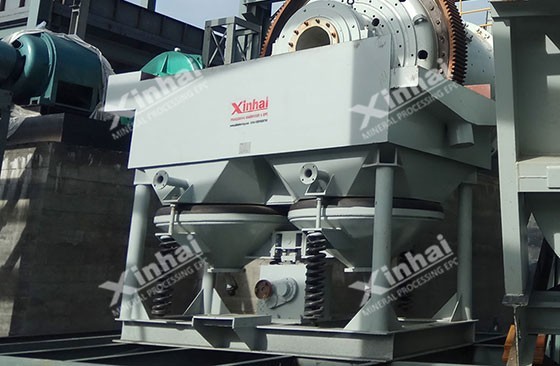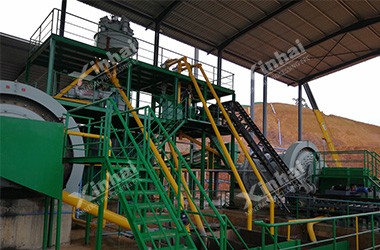

Warm Tip: If you want to know more details about equipment, solutions, etc, please click the button below for free consultation, or leave your requirements!
Jigging process is one of the most effective gravity separation methods used to deal with coarse ore with large density difference, which mainly utilizes the flow of vertical alternating medium (usually water or air) caused by strong vibration to make ore particles stratified according to relative density and collect light and light minerals by appropriate methods, thus achieving the separation purpose.
There are several factors that affect the jigging process, mainly include the stroke, jig frequency, ore feeding water,underscreen supplementary water, bed thickness, composition of artificial bed and feeding amount, which can be adjusted during the jigging process.
Although the composition of particle size and density of ore feeding, bed thickness, drop in screen plate, form of jigging cycle curve have important influence on the separation index of jigging process, the adjustable range of these factors is very limited in the jigging process.

Stroke and jig frequency are directly related to the bed looseness and looseness form, which have the decisive influence on the separation index of jigging process. They need to be determined according to the nature of the material and the thickness of the bed. The principle is:
(1) When the bed is thick and the processing capacity is large, the stroke should be increased and the jig frequency should be reduced accordingly;
(2) The large stroke and low jig frequency are often used to process the coarse material, small stroke and high jig frequency are often used to process the fine material.
Excessively increasing the jig frequency will make the bed too late to loose, then become too tight. When the jig frequency is especially high, the bed will even rise and fall as a whole like a piston, leading to a sharp drop in jigging index.
Therefore, the impact range of diaphragm jigging machine is generally 150~360 r/min, and the impact range of pneumatic jigging machine and movable sieve jigging machine is generally 30~80 r/min.
If the stroke is too small, the bed layer cannot be fully loose,and the coarse particles with high density cannot get the suitable space to transfer to the bottom layer. If the stroke is too large, the bed will be too loose, and the size and shape of particles will obviously interfere the layering according to the density.
When separating the material with width grades, the fine particles with high density will be largely lost in the low-density products. The proper jigging stroke is usually determined by the mineral processing test.
2. Ore feeding water and underscreen supplementary water
The total water consumption of jigging process is the sum of the ore feeding water and the underscreen supplementary water.
The ore feeding water is mainly used to wet the feeding and make it have proper fluidity. The solid mass fraction in the feeding is generally 30%~50%, which should remain stable.
The underscreen supplementary water is the main way to adjust the bed looseness. Please noted that the underscreen supplementary water can be increased to improve the layering speed of the materials when dealing with the narrow-graded material. While the underscreen supplementary water can be decreased to strengthen the suction effect when dealing with wide-graded materials.
3. Bed thickness and artificial bed
The thickness of the bed in the jigging machine (including the artificial bed) is the height of the sieve plate to the overflow dam. The suitable bed thickness is determined by the type of jigging machine, the density difference of components to be separated in the feeding and feed size.
For example, when using a diaphragm jigging machine to process the medium or fine-grained materials, the total thickness of the bed should not be less than 5 - 10 times the maximum particle size of the feed, generally 120 -300mm. The thickness of bed can reach 500mm when handling the coarse material.
In addition, when the density difference of the components is large, the bed can be thinner to increase the distance of delamination and improve the production capacity of the jigger. When the density difference of the components is small, the bed can be thicker to improve the quality of high-density products. But the thicker the bed is, the less productive the jigging machine is.
The artificial bed is the main means to control the discharging speed through the screen and the quality of high-density products. In the production, the artificial bed must be kept at the bottom of the bed. For this reason, the particle size of the material used for the artificial bed should be 2-3 times of the size of the sieve hole, and 3-6 times larger than the maximum particle size of the selected material. High density coarse particles are often used as artificial bed in the production.
When separating the fine-grained materials, the laying thickness of the artificial bed is generally 10~50mm, while separating the coarse-grained materials, the laying thickness can reach 100mm. The higher the density of the artificial bed, the smaller the particle size, the larger the thickness of the laid bed, the lower the yield of the high-density products, the lower the recovery rate, but the higher the density.

4. Drop in screen plate
The elevation difference between the two adjacent sieve plates of jigging chamber is called the drop of screen plate,which is helpful to push the material towards the discharge end.
Generally, when processing coarse material with large density difference among the components,the drop should be larger; When processing the fine-grained or refractory material,the drop should be smaller. Generally, the drop of screen plate for the coarse-grained jigging machine can reach 100mm.
5. Feeding property and feeding quantity
The processing capacity of jigging machine is closely related to the nature of ore feeding. When the coarse and easily separated ore is processed and the quality demand on the high-density product is not high, the ore feeding can be larger. At the same time, in order to obtain a better separation index, the size composition, density composition and concentration of ore feeding should be as stable as possible, especially the amount of ore feeding cannot to fluctuate too much.
The processing capacity of jigging machine varies greatly with the feeding size, density difference of components to be separated in feeding, operating requirements and specifications of jigging machine.
Conclusion
There are the five technological factors that affect jigging process: stroke and jig frequency, ore feeding water and underscreen supplementary water, bed thickness and composition of artificial bed, drop of screen plate, feeding properties and feeding quantity. When the ore dressing index changes obviously, the jigging machine operator can make corresponding adjustments according to the above five points, so as to maintain the normal production of ore dressing plant.
Last: Common Types of Spiral Classifier Used in the Mineral Processing
Next: Application of Froth Flotation Process in The Rock Type Gold Mining Process


Summary of Gold Cyanidation Methods
 8388
8388
 996
996